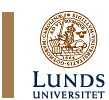

|
Panel No. 37Panel Title: Politics in Gujarat: From Congress to HindutvaConvenor: Radhika
Desai, Dept of Political Science, University of Victoria, Canada Venue:
Lilla
Salen (Little Hall) in the Academic Society
Building, Sandgatan 2 Panel Abstract: Gujarati politics has made the clearest transition from Congress to Hindutva. This panel proposed to examine the social, economic and cultural basis of this transition in Gujarat and reflect on the light it sheds on the politics of India as a whole and other parts of India. The papers will examine relevant periods and phenomenon of Gujarati politics as well as the role of major political actors: classes, castes and political parties.
Papers accepted for presentation in the panel:Paper Giver 1: Radhika Desai, University of Victoria, Canada Paper 1 Title: The BJP
and the Middle Castes in Gujarat Paper Giver 2: Suhas Palshikar, Dept. of Politics, University of Pune, India Paper 2 Title: Regional Route of the Communal: Lesson from Gujarat (and Maharahstra) Paper Abstract: The communal upsurge
in Gujarat (2002) had one distinguishing feature. It did not evoke
a very strong condemnation by the Gujarati society. While many explanations
can be given for this muted response, one reason why the Gujarati
society chose to ‘tolerate’ the communal excesses was
the skilful linking of the communal identity with Gujarati identity.
Invocation of Gujarati asmita (pride) distorted the terms of the
debate over communalism. This poses a question: can the communal
be legitimated in the name of the regional? Paper Giver 3: Ghanshyam Shah, Jawaharlal Nehru University, New Delhi, India Paper 3 Title: The BJP and the Deprived Communities Paper Abstract: In this paper I will focus on the shifting support base of the Congress and the BJP. The former was dominating Gujarat politics till the mid1980s except a brief gap of 1975. From the late ‘eighties it began to loose electoral battle; and occupies only 51 seats in the assembly of 181 members. On the other hand, the BJP which had only three seats in 1972, has captured 126 seats in the last assembly elections in 2002. The Congress began to loose its support of the upper (including middle) castes from the mid-sixties because of its pro-poor posture and some of the measures like land reform that adversely affect the interests of the upper castes. From the mid seventies, the party followed a strategy, called KHAM – alliance of the OBCs, SCs, STs and Muslims (constituting nearly 70 percent of the population)- in distribution of tickets and mobilisation in elections. The deprived communities began to identify the Congress as pro-poor. That further alienated the upper castes from the party. However from the late 1980s the BJP followed the Congress’ strategy of wooing the deprived communities excluding Muslims to win electoral battle. While doing so it has so far retained intact its support base and hegemony of the upper castes. That is well within its ideology. And some extent the strategy has worked in its favour in winning elections and communalizing politics. How long the party will be able to maintain this strategy keeping the upper and deprived communities together? I shall analyze the strategies adopted by the BJP to win over the deprived communities for elections and Hindutva politics. Paper Giver 4: Judith Whitehead, University of Lethbridge, Alberta, Canada Paper 4 Title: Expulsion of Gandhi from the Land of Gandhi: An Examination of Environmental Discourse and the Capitalization of Agriculture in Gujarat Paper Abstract: Using both discursive and ethnographic material, this paper examines the reasons why environmental concerns with sustainable development have been treated with general hostility in contemporary Gujarat. Since many environmental issues are framed through the lens of Gandhi, this paper focuses on a class analysis of Gandhian ideology, arguing that the environmental aspects of Gandhi’s thought interpolate the worldview of small-scale producers who might still possess an important element of subsistence production. The capitalization of agriculture has given rise to a new constellation of propertied classes spanning both city and countryside, whose worldview is interpolated through an aggressive assertion of Hindu identity. The rejection of Gandhi thus expresses and mirrors increasing class polarization in the Gujarat countryside, providing the agrarian elite with an ideological entry point into the hegemonic unity of the new propertied and fully market-oriented classes.
SASNET - Swedish South Asian Studies Network/Lund
University
|

